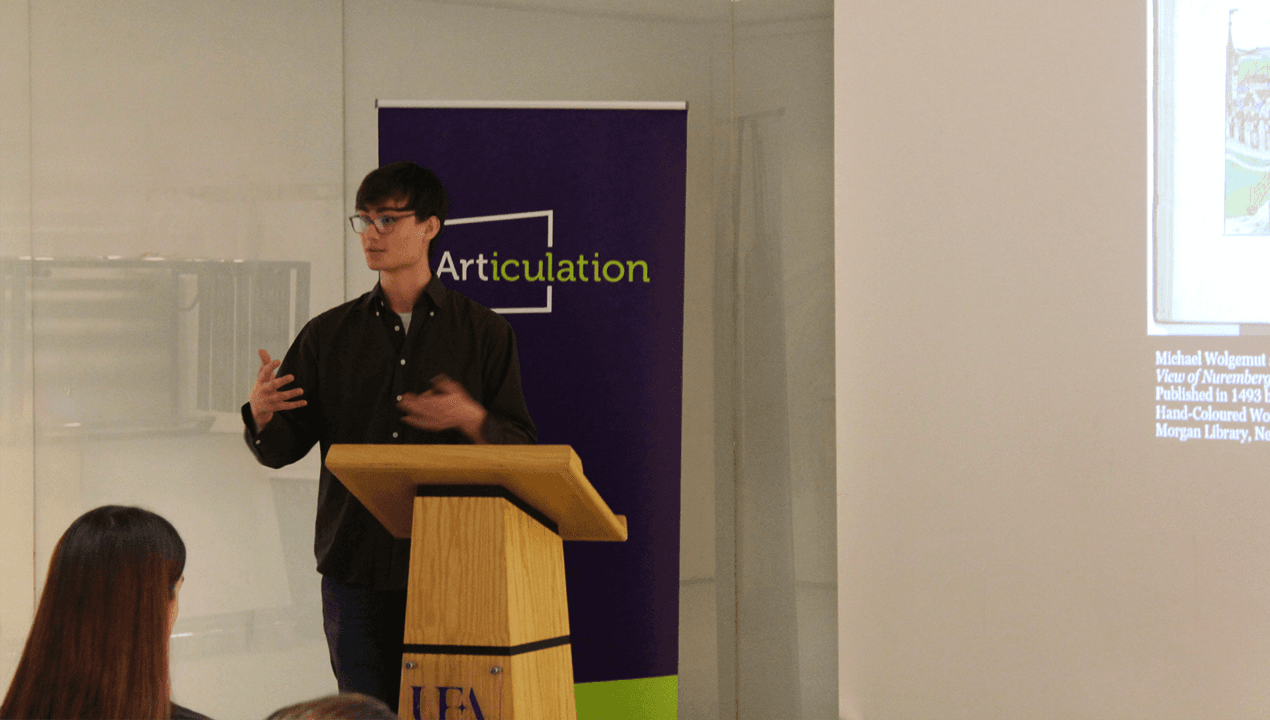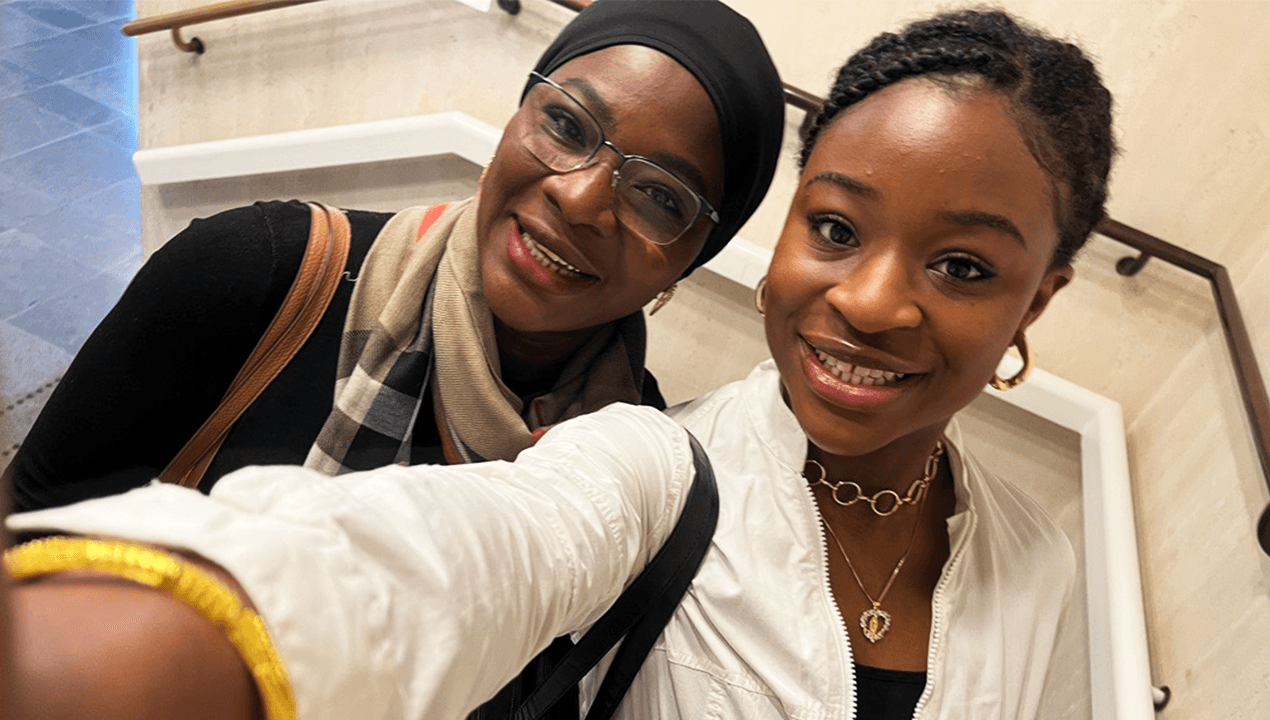
James Rayner
About
James Rayner is a Y13 student who studies History of Art, Music and Religious Studies. In 2024, he competed in the ARTiculation talks.
Our interview with James Rayner
We sat down with James to hear how he got on at the ARTiculation awards, his talk on Albrecht Durer’s ‘Knight, Death and the Devil’ and his upcoming talks with the National Gallery.
How did you find out about this competition and how have your teachers supported you during this process?
When Y13 began, Tim approached me about doing a talk, the subject of which was completely at my discretion, and he helped me over several months to finalise a topic and fine-tune both my talk and public speaking skills to the needs of the competition.
Tim reminded me that often, the success of ARTiculation talks hinges on an ability to communicate a personal passion about your subject; and initially, I was not particularly taken by that prospect. My conception of Art History has always been largely impersonal, and I see the History of Art really as a continuum of "usage" in the sense that everything from the act of making art itself right through to the work, for example, being posted as a meme are distinct moments of usage; each equally relevant to the art historian, who must be receptive to the variety of these uses, yet not become a "user" themselves; insofar as they should re-aestheticize the work.
I'm very grateful to Tim for letting me be integral to a more "academic" style of talk that encompassed my ways of working and principles on art historical practice. But his most indispensable advice concerned how to integrate academics with my own opinions to create something refreshing and appropriate for the competition. He consistently advised me on what needed cutting down and clarifying to create a more fluid presentation, and it was great to have a second opinion throughout to keep the presentation focussed and accessible, especially considering the relative complexity of the subject matter.
Your talk was about Albrecht Durer’s ‘Knight, Death and the Devil’, could you go over some of the key points you covered?
"Knight, Death and the Devil" has spilt much ink, from the pens of many art historians; and really my goal was not to provide an eternal answer to what Dürer meant by his famous print, but rather to place it within the wider context of his work and particularly, his place as a Humanist in 16th century Europe.
The popular interpretation of the print was most clearly articulated in the 1960s by Erwin Panofsky, one of the 20th century's most important art historians. I began by examining the work's relation to the theology of Desiderius Erasmus. It was Panofsky's view that the image exemplified the distinctly Erasmian image of the undeterred Christian Knight, eschewing the physical and sinful distractions of the world and adopting an intellectually rigorous approach to Christian belief, which is really the defining tenet of Erasmus' theological system and was expounded most obviously in his 1501 text, Handbook of a Christian Knight.
Erasmus, as the so-called "Prince of Humanists", was a fitting place to start in terms of examining Dürer's Humanism; but I wanted to expand the conversation by examining the incredible horse which the knight rides as a further demonstration of Humanist ideals in his art. Not least, because I found evidence throughout my research to doubt his knowledge of the text explicitly outlined by Panofsky.
So, to examine his interests in Equine proportion and representation, I focused on his encounters with civic Equestrian statues in Italy (particularly those of Verrocchio and the Horses of St Mark in Venice) and the contemporary Humanist conception of biology as not only a revival of Aristotelian and Classical science, but as a standard for art. It was my view, as I put it during the talk, that Dürer's horse, like the stoic knight's quest, was an act of quasi-Erasmian meditation on biology as a means of revelation into divine creation; mediated through Dürer's self-image as an artist and a Humanist.
To achieve this, he undertook several theoretical projects; a few of which I described throughout the presentation but is probably most clearly seen in his proportional books like the unfinished "Apprentice's Fayre" (1508), a text in which we know Dürer intended to produce a study of equine proportions.
There is plenty of scholarship which denies, or at least de-emphasises the influence of Humanism on the work; but as I said, set "meaning" is never my concern. Dürer was undoubtedly familiar with Humanist thought, and many of the intellectual circles in Germany had interests in equestrianism. Fittingly, they also modelled themselves on knights and chivalric orders, who, at the time were undergoing a sort of identity-crisis following the recent death of the newly berated "Warrior Pope", Julius II in the February of 1513, the same year Dürer finished "Knight, Death and the Devil". An explicitly "militaristic" image would have no doubt soured the contemporary response, particularly amongst the Humanists, who were often committed pacifists. Erasmus in particular was highly critical of Julius II, publishing the satirical dialogue "Julius Excluded from Heaven" in 1514. It was therefore my view that if we are to consider "Knight, Death and the Devil" as a "Humanist" image, it can be understood best by placing the image in the philosophy's wider context, mainly in zoology and international discourse. After all, Erasmus' book and the print are separated by a period of 12 years, and the image of the knight changed greatly over that time; so much that it eventually became aligned, as said, with the Humanists themselves.
Dürer himself is part of this story, and I think really the wonderful thing about "Knight, Death and the Devil" is that it can so clearly articulate the central concerns of his entire career within a single and indeed, masterfully produced image.
What were some of the highlights of this day?
The Sainsbury Centre houses a wonderful collection, in a unique and well-curated space and while I didn't have loads of time to look about, I must say that their abundance of Modigliani's was a real treat as his work is a particular favourite.
I had a wonderful conversation with the adjudicator for the day, Ben Street; an art historian and lecturer at UEA/Oxford about how I took on Dürer as the subject of my talk. It was a real honour to hear such kind words about my research and that I'd managed to take such a famous artist and put him in a refreshing light. I met some wonderful people and I think that's really the highlight that stands out.
Your talk was received so well that you've now been recruited to give lectures at the National Gallery. How did this come about?
It came rather quickly in all honesty, I had coffee with some of the NG staff during the interval where we discussed the Friday Lates programme and parts of the Articulation Alumni, but it was really only after Amira had been announced (deservedly so, I must add) as the winner, that Josepha from ARTiculation asked whether I'd be interested in doing so. Naturally, I was absolutely thrilled and am super grateful for even the consideration.
Do you know when these talks will occur, how many there will be and what you plan to discuss?
Not at the moment, I believe I will find out in April. As for subjects/details, I am also currently unsure; though I do know that I'm hopefully going to be involved with the NG's "Friday Lates" programme, which often invites ARTiculation alumna to do talks and panel discussions related to various topics. Luckily, most of the NG's collection is right in my art historical "wheelhouse" per se, so I look forward to working with a collection I'm at least familiar with.

